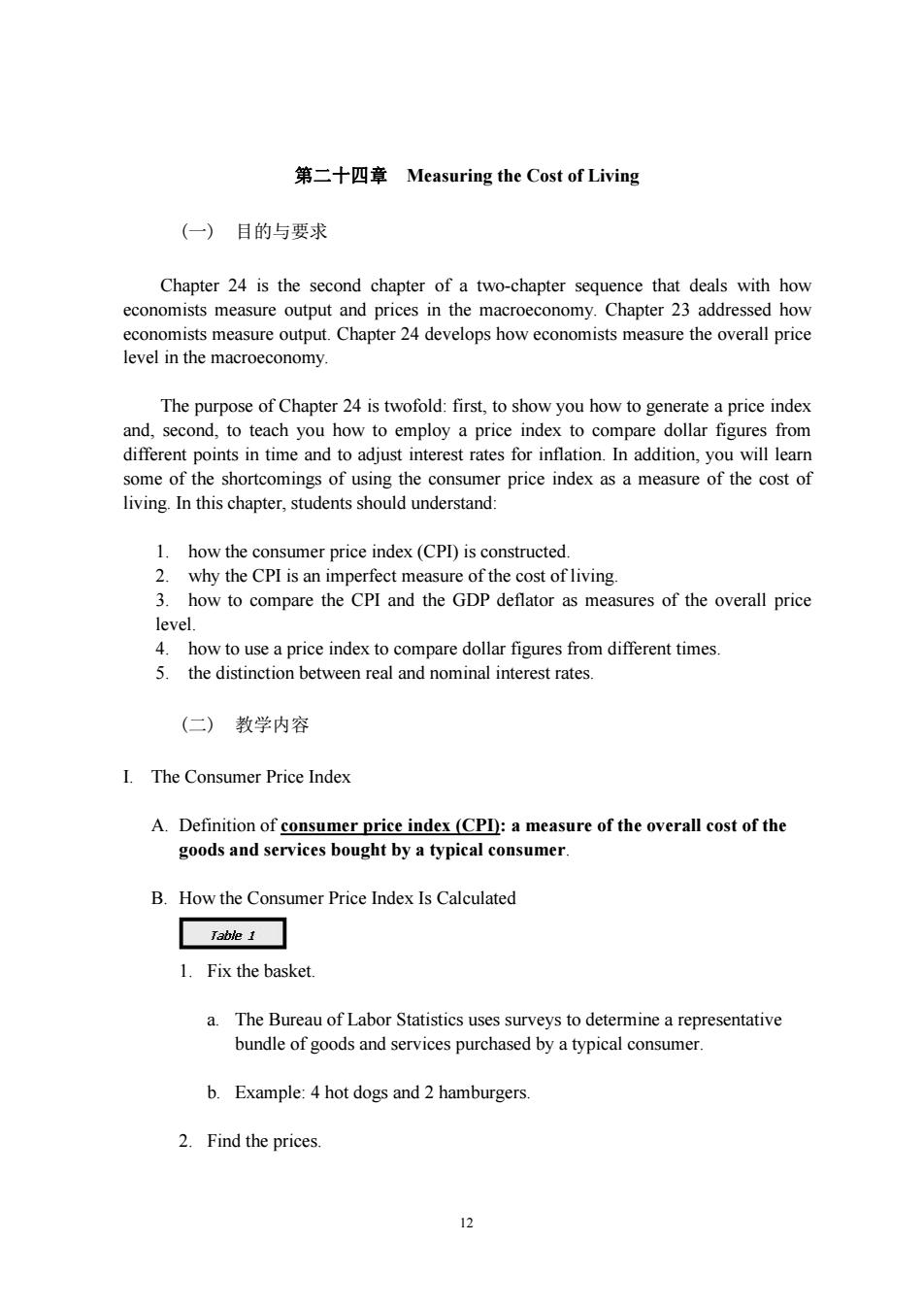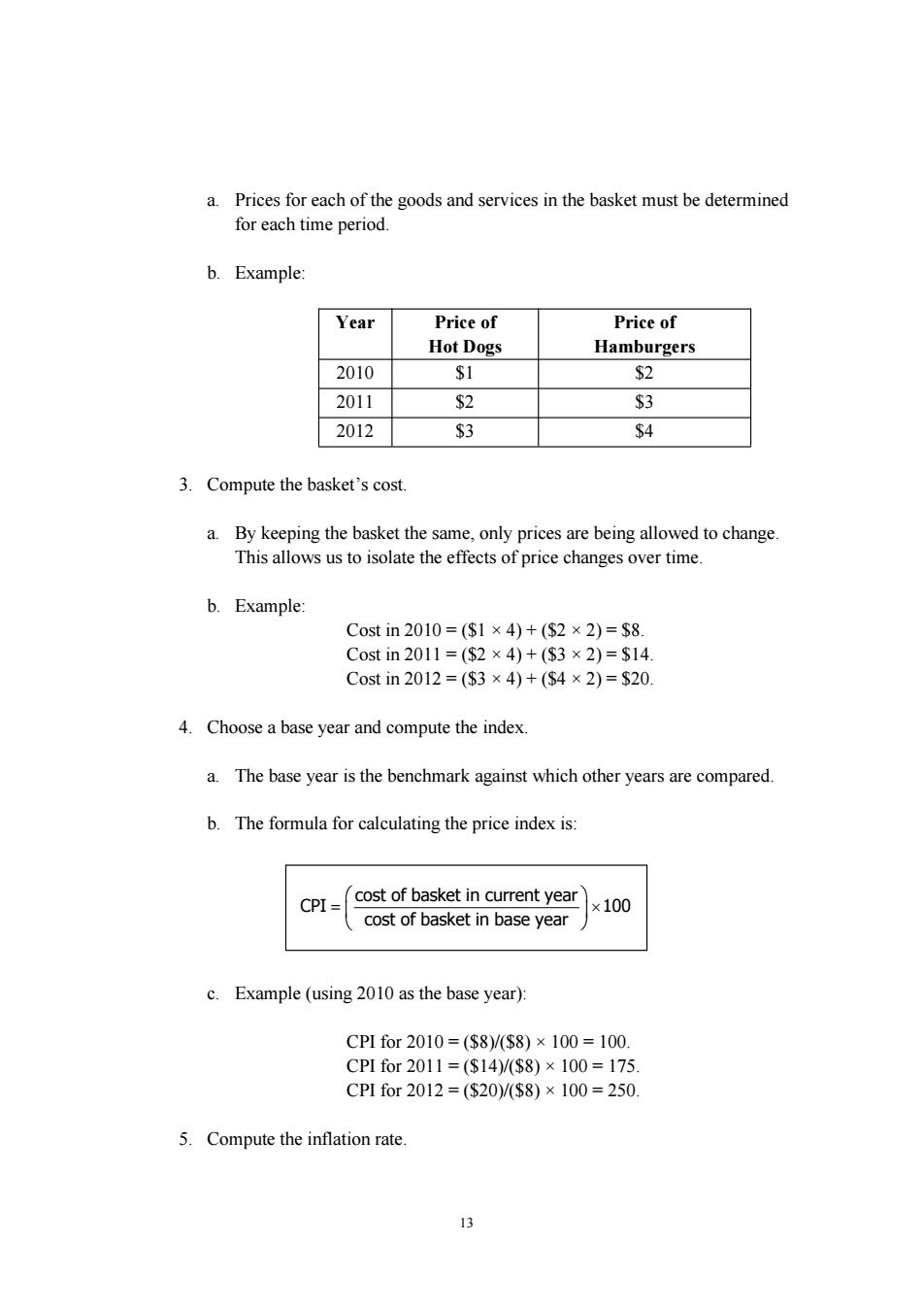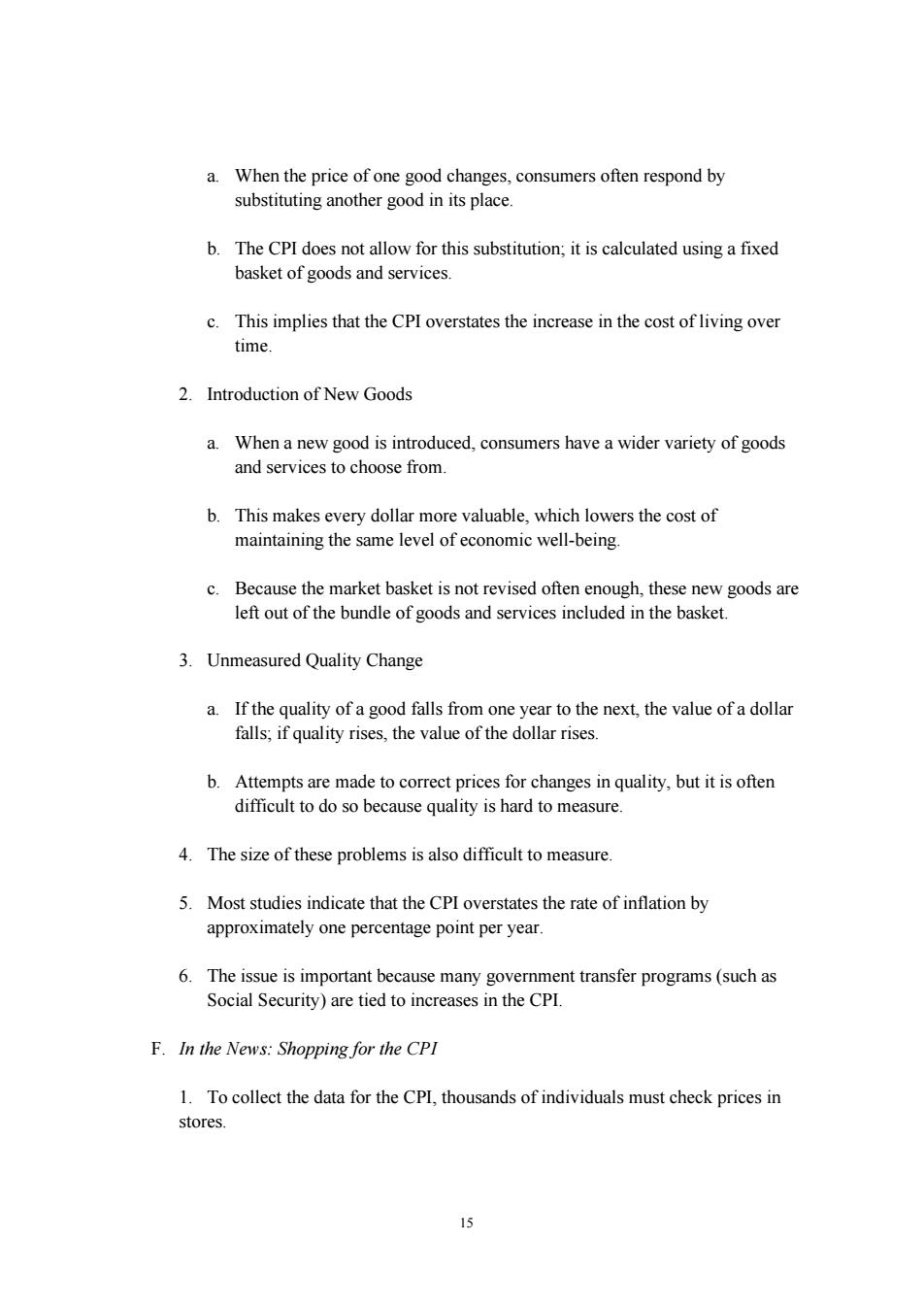
2.This article compares the underground economies of the United States and several other countries. E.Case Study:International Differences in GDP and the Quality of Life 1.Table 3 shows real GDP per person,life expectancy,adult literacy rates,and Internet usage for 12 countries. 2.In rich countries,life expectancy is higher and adult literacy and Internet usage rates are also high. 3. In poor co ntries,people typically live only into their about halfof the adult population is literate,and Interet usage is very rare. (三)思政设计 从国家统计公报、国际MF组织等网站报告链接、权威GDP等数据导入开始, 了解中国与国际经济形势,中国GDP的变化。复习提问GDP概念、 核算方法。使得 学生不仅意识到中国改革开放后巨大成就,增强”道路自信”, 而且了解和重视高质量 发展。通过理论实践比对,加深对知识的了解,夯实基础知识。 (四)课后练习 1.Explain why an economy's income must equal its expenditure 2.Which contributes more to GDP -the production of an economy car or the production of a luxury car?Why? 3.A farmer sells wheat to a baker for $2.The baker uses the wheat to make bread,which is sold for $3.What is the total contribution of these transactions to GDP? 4.Many years ago,Peggy paid $500 to put together a record collection.Today,she sold her alb ms at a garage s e for $100.How does this sale affect current GDP? 5.List the four components of GDP.Give an example ofeach (五)教学方法与手段 本章教学主要采用课堂讲授、多媒体教学、分组讨论、课堂讨论等。 11
11 2. This article compares the underground economies of the United States and several other countries. E. Case Study: International Dif erences in GDP and the Quality of Life 1. Table 3 shows real GDP per person, life expectancy, adult literacy rates, and Internet usage for 12 countries. 2. In rich countries, life expectancy is higher and adult literacy and Internet usage rates are also high. 3. In poor countries, people typically live only into their 50s, only about half of the adult population is literate, and Internet usage is very rare. (三)思政设计 从国家统计公报、国际 IMF 组织等网站报告链接、权威 GDP 等数据导入开始, 了解中国与国际经济形势,中国 GDP 的变化。复习提问 GDP 概念、核算方法。使得 学生不仅意识到中国改革开放后巨大成就,增强“道路自信”,而且了解和重视高质量 发展。通过理论实践比对,加深对知识的了解,夯实基础知识。 (四)课后练习 1. Explain why an economy’s income must equal its expenditure. 2. Which contributes more to GDP—the production of an economy car or the production of a luxury car? Why? 3. A farmer sells wheat to a baker for $2. The baker uses the wheat to make bread, which is sold for $3. What is the total contribution of these transactions to GDP? 4. Many years ago, Peggy paid $500 to put together a record collection. Today, she sold her albums at a garage sale for $100. How does this sale affect current GDP? 5. List the four components of GDP. Give an example of each. (五)教学方法与手段 本章教学主要采用课堂讲授、多媒体教学、分组讨论、课堂讨论等

第二十四章Measuring the Cost of Living (一)目的与要求 Chapter 24 is the second chapter of a two-chapter sequence that deals with how economists measure output and prices in the macroeconomy.Chapter 23 addressed how economists measure output.Chapter 24 develops how economists measure the overall price level in the macroeconomy. The purpose of Chapter 24 is twofold:first,to show you how to generate a price index and,second,to teach you how to employ a price index to compare dollar figures from different points in time and to adjust interest rates for inflation.In addition,you will learn some of the shortcomings of using the consumer price index as a measure of the cost of living.In this chapter,students should understand: 1. how the consumer price index(CPI)is constructed. 2. why the CPI is an imperfect measure of the cost of living. 3.how to compare the CPI and the GDP deflator as measures of the overall price evel 4 how to use a price index to compare dollar figures from different times 5. the distinction between real and nominal interest rates. (二)教学内容 I.The Consumer Price Index A.Definition of price index (CP):msure of the overall cost o the goods and services bought by a typical consumer B.How the Consumer Price Index Is Calculated ab咖1☐ 1.Fix the basket a.The Bureau of Labor Statistics uses surveys to determine a representative bundle of goods and services purchased by a typical consumer. b.Example:4 hot dogs and 2 hamburgers. 2.Find the prices
12 第二十四章 Measuring the Cost of Living (一) 目的与要求 Chapter 24 is the second chapter of a two-chapter sequence that deals with how economists measure output and prices in the macroeconomy. Chapter 23 addressed how economists measure output. Chapter 24 develops how economists measure the overall price level in the macroeconomy. The purpose of Chapter 24 is twofold: first, to show you how to generate a price index and, second, to teach you how to employ a price index to compare dollar figures from different points in time and to adjust interest rates for inflation. In addition, you will learn some of the shortcomings of using the consumer price index as a measure of the cost of living. In this chapter, students should understand: 1. how the consumer price index (CPI) is constructed. 2. why the CPI is an imperfect measure of the cost of living. 3. how to compare the CPI and the GDP deflator as measures of the overall price level. 4. how to use a price index to compare dollar figures from different times. 5. the distinction between real and nominal interest rates. (二) 教学内容 I. The Consumer Price Index A. Definition of consumer price index (CPI): a measure of the overall cost of the goods and services bought by a typical consumer. B. How the Consumer Price Index Is Calculated 1. Fix the basket. a. The Bureau of Labor Statistics uses surveys to determine a representative bundle of goods and services purchased by a typical consumer. b. Example: 4 hot dogs and 2 hamburgers. 2. Find the prices

a.Prices for each of the goods and services in the basket must be determined for each time period. b.Example: Year Price of Price of Hot Dogs Hamburgers 2010 $2 2011 $2 3 2012 S3 3.Compute the basket's cost. a.By keeping the basket the same,only prices are being allowed to change This allows us to isolate the effects of price changes over time. b.Example Cost in2010=(S1×4)+(S2×2)=$8 Cost in2011=($2×4)+(③3×2)=$14 Cost in2012=($3×4)+(③4×2)=$20 4.Choose a base year and compute the index a.The base year is the benchmark against which other years are compared. b.The formula for calculating the price index is: Icost of basket in cumrent year0 cost of basket in base year c Example(using 2010 as the base year) CPI for2010=($8)/$8)×100=100. CPI for2011=(S14)/($8)×100=175. CPI for2012=($20)/$8)×100=250. 5.Compute the inflation rate 13
13 a. Prices for each of the goods and services in the basket must be determined for each time period. b. Example: Year Price of Hot Dogs Price of Hamburgers 2010 $1 $2 2011 $2 $3 2012 $3 $4 3. Compute the basket’s cost. a. By keeping the basket the same, only prices are being allowed to change. This allows us to isolate the effects of price changes over time. b. Example: Cost in 2010 = ($1 × 4) + ($2 × 2) = $8. Cost in 2011 = ($2 × 4) + ($3 × 2) = $14. Cost in 2012 = ($3 × 4) + ($4 × 2) = $20. 4. Choose a base year and compute the index. a. The base year is the benchmark against which other years are compared. b. The formula for calculating the price index is: cost of basket in current year CPI 100 cost of basket in base year c. Example (using 2010 as the base year): CPI for 2010 = ($8)/($8) × 100 = 100. CPI for 2011 = ($14)/($8) × 100 = 175. CPI for 2012 = ($20)/($8) × 100 = 250. 5. Compute the inflation rate

a.Definition of inflation rate:the percentage change in the price index from the preceding period. b.The formula used to calculate the inflation rate is inflation rate (CPI2-CPIvx100% c.Example: Inflation Rate for2011=(175-100)/100×100%=75%. Inflation rate for2012=(250-175/175×1009%=43% C.The Producer Price Index 1.Definition of producer price index (PPD):a measure of the cost of a basket of goods and services bought by firms. 2. Because firms eventually pass on higher costs to consumers in the form of higher prices on products,the producer price index is believed to be useful in predicting changes in the CPI. D.FYI:What Is in the CPI's Basket? e1☐ 1.Figure I shows the makeup of the market basket used to compute the CPI. 2.The largest category is housing.which makes up 43%of a typical consumer's budget. E.Problems in Measuring the Cost of Living 1.Substitution Bias 14
14 a. Definition of inflation rate: the percentage change in the price index from the preceding period. b. The formula used to calculate the inflation rate is: c. Example: Inflation Rate for 2011 = (175 – 100)/100 × 100% = 75%. Inflation Rate for 2012 = (250 – 175)/175 × 100% = 43%. C. The Producer Price Index 1. Definition of producer price index (PPI): a measure of the cost of a basket of goods and services bought by firms. 2. Because firms eventually pass on higher costs to consumers in the form of higher prices on products, the producer price index is believed to be useful in predicting changes in the CPI. D. FYI: What Is in the CPI’s Basket? 1. Figure 1 shows the makeup of the market basket used to compute the CPI. 2. The largest category is housing, which makes up 43% of a typical consumer’s budget. E. Problems in Measuring the Cost of Living 1. Substitution Bias

a.When the price of one good changes,consumers often respond by substituting another good in its place. b.The CPI does not allow for this substitution;it is calculated using a fixed basket of goods and services c.This implies that the CPI overstates the increase in the cost of living over time. 2.Introduction of New Goods a.When a new good is introduced,consumers have a wider variety of goods and services to choose from. b.This r more valuable,which lowers the cost of maintaining the same level of economic well-being. c.Because the market basket is not revised often enough,these new goods are left out of the bundle of goods and services included in the basket. 3.Unmeasured Quality Change a.If the quality of a good falls from one year to the next,the value of a dollar falls;if quality rises,the value of the dollar rises. prices for changes in quality.but it is ofer difficult to do so because quality is hard to measure. 4.The size of these problems is also difficult to measure. 5.Most studies indicate that the CPI overstates the rate of inflation by approximately one percentage point per year 6.The issue is important because many government transfer programs(such as Social Security)are tied to increases in the CPI. F.In the News:Shopping for the CPI 1.To collect the data for the CPI.thousands of individuals must check prices in stores. 15
15 a. When the price of one good changes, consumers often respond by substituting another good in its place. b. The CPI does not allow for this substitution; it is calculated using a fixed basket of goods and services. c. This implies that the CPI overstates the increase in the cost of living over time. 2. Introduction of New Goods a. When a new good is introduced, consumers have a wider variety of goods and services to choose from. b. This makes every dollar more valuable, which lowers the cost of maintaining the same level of economic well-being. c. Because the market basket is not revised often enough, these new goods are left out of the bundle of goods and services included in the basket. 3. Unmeasured Quality Change a. If the quality of a good falls from one year to the next, the value of a dollar falls; if quality rises, the value of the dollar rises. b. Attempts are made to correct prices for changes in quality, but it is often difficult to do so because quality is hard to measure. 4. The size of these problems is also difficult to measure. 5. Most studies indicate that the CPI overstates the rate of inflation by approximately one percentage point per year. 6. The issue is important because many government transfer programs (such as Social Security) are tied to increases in the CPI. F. In the News: Shopping for the CPI 1. To collect the data for the CPI, thousands of individuals must check prices in stores